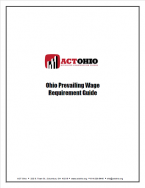
A recent study by completed by Bowling Green State University, Kent State University, Colorado State University, and the Midwest Economic Policy Institute confirms that Ohio’s Prevailing Wage law is helping to rebuild Ohio’s middle class and strengthen the state’s economy.
According to this study, Prevailing Wage laws promote a skilled, highly-trained construction workforce. Download the study here.
• Construction workers in states with Prevailing Wage laws are up to 30% more productive that their counterparts in states without the law.
• States without Prevailing Wage law have higher worksite fatality rates.
• Prevailing Wage repeal reduces registration in apprenticeship programs by 40%.
• Prevailing Wage prevents the use of cheap outside labor, promoting the use of skilled local craftspeople.
The study also concludes that labor amounts to just 23% of construction costs across the country.
To our west, Indiana Assistant Majority Leader Rep. Ed Soliday (R) told attendees at the 2017 TDA Economic Forum “We got rid of Prevailing Wage and so far it hasn’t saved us a penny… There is NOT a 22% cost savings when the total cost of labor is 22%.”
In neighboring West Virginia, the School Building Authority (SBA) is not seeing a reduction in construction costs that was promised with the repeal of Prevailing Wage. According to their March 2017 report, “The overall cost of school construction does not reflect a reduction of overall construction costs on SBA projects…At this time, the SBA is not realizing an overall savings.”
The report also notes that “The wages paid to an employee post-repeal are lower than those paid prior to the repeal,” giving an example of the “race to the bottom” that occurs when workers’ wages are not protected.
ACT Ohio works to defend and protect the State of Ohio’s Prevailing Wage Law, which has been in place since 1931. Through its support of the law, ACT Ohio is working to ensure the sustainability of a construction workforce that delivers quality projects on time and on budget and supports local economies.
What are Davis-Bacon Prevailing Wages?
The Davis-Bacon and Related Acts establish the U.S. Department of Labor as the agency responsible for determining and enforcing the prevailing wages to be paid by contractors and subcontractors to workers on federally funded construction projects.
How is Davis-Bacon Applied?
Davis-Bacon applies to contractors and subcontractors performing construction, alteration, or repair (including finishing trades) work on federally funded or federally assisted contracts in excess of $2,000. Under Davis-Bacon and Related Acts, contractors and subcontractors must pay tradespeople, laborers, service people and mechanics no less than the prevailing wages and fringe benefits that apply on local projects.
According to the U.S. Department of Labor:
“For prime contracts in excess of $100,000, contractors and subcontractors must also, under the provisions of the Contract Work Hours and Safety Standards Act, as amended, pay laborers and mechanics, including guards and watchmen, at least one and one-half times their regular rate of pay for all hours worked over 40 in a workweek. The overtime provisions of the Fair Labor Standards Act may also apply to DBA-covered contracts.”
The U.S. Department of Labor Wage & Hour Division provides guidance and resources on Davis-Bacon Prevailing Wages.
For questions on determining the accurate Davis-Bacon Prevailing Wage on your construction project in Ohio, contractors and subcontractors can get rates by contacting ACT Ohio at info@actohio.org or 614-228-5446.

Need help navigating Ohio’s Prevailing Wage requirements?
ACT Ohio has created an Ohio Prevailing Wage Requirement Guide. Click here to download this free resource containing requirements, timelines, forms, and other helpful information. Still have questions? Contact ACT Ohio at 614-228-5446 or info@actohio.org.
